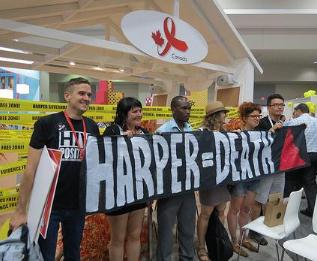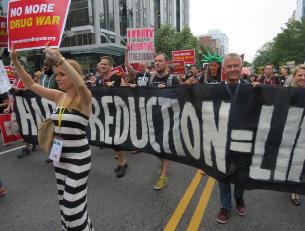
Activists wrapped the Canadian booth with yellow caution tape labelled "Harper Government-Evidence Free Zone." Credit: AIDS Action Now
“Medically and scientifically, nothing spectacular,” said Dr Philip Berger over the phone from Washington toward the end of the 19th International AIDS Conference, held July 22 to 29. “AIDS as an inflammatory disease, basic science on activating latent cells so the virus can be killed, looking at accentuated aging and higher prevalence of unrelated illnesses like diabetes and heart disease . . . all tiny, incremental bits of knowledge.”
It was perhaps this lack of hard news that made the major story coming out of the conference that of Timothy Ray Brown, the “Berlin Patient.” Brown, who had leukemia, went through the dangerous, last-resort procedure of first having his immune system wiped out with chemotherapy, then getting a bone marrow transplant to reboot it. The procedure also managed to kill off his HIV. That’s not exactly practical for those of us living with the virus. Brown was very lucky to survive it. As well, for anyone who has been paying attention, this was old news. Brown actually spoke about his experience in Toronto at the OHTN research conference back in 2011.
So does this all mean the conference was a flop? I didn’t go this time, but I’ve been at the last three, and I’ve heard the grumbling — increasingly about photo ops for stars and politicians; just a PR and advertising moment for big pharma; a playground for activists; if there is a medical breakthrough, nobody waits for a conference; it’s all over the web in minutes; a colossal waste of money that could be better spent elsewhere.
On the other hand, my inbox has been filled with reports from AIDS Action Now and others. They denounced US immigration rules that prevented sex workers and drug users from getting to Washington and wrapped the Canadian booth with yellow caution tape labelled “Harper Government — Evidence Free Zone.”
Then there were the images of Dr Berger being hustled away by a burly security guard after he confronted Minister of Health Leona Aglukkaq about federal government cuts to health services for refugees, the massive “We Can End AIDS” march to the White House demanding economic justice and human rights, including a “Tobin Tax” on financial transactions to pay for global health, and Health Minister Aglukkaq again, this time framed by a huge banner declaring “Harm Reduction = Life,” as Canadian activists turned their backs on her speech at the regional session.
While some complain that the “decline” of scientific and medical news shows that the conferences are becoming less relevant, I would argue that it reflects a deeper shift in what is relevant in ending AIDS.
When we seized the stage at the fifth International AIDS Conference in Montreal in 1989, we needed medicines to keep us alive. Today we have medicines that (imperfectly) do that, but around the world, people continue to die. We know how to keep people well. We just don’t do it. Medical science grinds on, producing its incremental knowledge, but increasingly, social issues are coming to the fore as key to ending the epidemic.
Even the conference-opening session, featuring luminaries such as Anthony Fauci and Hillary Clinton, pointed out that we already possess the tools necessary to end the epidemic. And the talk about finding a cure that used the Berlin Patient as a springboard was more about marshalling the political will and resources to speed up research than about research itself.
So it wasn’t surprising that Dr Eric Mykhalovskiy is more upbeat. He’s a sociology professor at York University, and much of his recent work has focused on criminalization of HIV. “AIDS 2012 saw the emergence of a global movement against the criminalization of HIV. We had a fabulous meeting organized by Edwin Bernard with activists from Canada, US, the Netherlands, Sweden, Switzerland, Germany, Denmark, England and elsewhere, sharing for the first time political and other strategies for stopping the criminalization of HIV nondisclosure.” Back in Canada, interest around criminalization generated by the conference contributed to the Toronto Star’s publication of an important op-ed piece on how snowballing criminal prosecutions for nondisclosure are fanning the flames of the epidemic.
AIDS Action Now’s Alex McClelland said he found the conference “quite inspiring for once.” He noted the development of a critique of the acronym MSM, more attention paid to gay men, and more talk about how homophobia is driving the epidemic. He was also happy to see indigenous people’s issues much more present, with the first-ever main conference session bringing together indigenous leaders on HIV from Australia, Canada, Chile, Mexico and other countries, and an “amazing” Decolonize HIV networking zone.
If many of the key issues about AIDS have now shifted from the medical to the social, activism represents the political muscle to actually demand implementation. Conferences have become an opportunity to hold governments accountable and embarrass them on an international stage when they screw up. When AIDS Action Now chanted, “Harper Equals Death” and wrapped the Canadian booth in caution tape, when activists interrupted Aglukkaq’s speech, they were bringing an important message about the implications of government policies and undermining the rigid Harper party line that everything is just fine in Canada.
“Harper’s agenda is to dismantle our country’s health and social safety net. His moralistic and criminalizing policies on drug use and opposition to harm reduction are creating a perfect storm for HIV and hep C infections to explode,” explained Zoe Dodd, a harm-reduction activist and member of AIDS Action Now.
The other major buzz building since the last conference in Vienna was talk about “Treatment = Prevention.” Those of us under successful anti-viral treatment are largely uninfectious. So the idea is that the spread of HIV can be stopped if everyone is on treatment. But Dr Alan Li, known for his frontline HIV work among immigrants in Toronto, pointed out it’s not nearly that simple: “The treatment-as-prevention bandwagon has left the station and is proceeding full force, with very limited analysis and discussion on the feasibility, practicality or ethical implications of its implementation. The increasing emphasis on biotechnical/biomedical interventions for prevention versus behavioural/educational approaches brings both promise and huge warning signs to the frontline.” Thanks to Washington, that questioning has begun. Medical science must listen to social science.
Since the emergence of AIDS activism in the late 1980s, we’ve always known the path to ending AIDS was as much political as scientific and medical. And as medical science has advanced, policy decisions about how that knowledge gets deployed – as well as the social science research that should inform those decisions and activists’ political pressure to see them implemented – have become even more crucial. That’s what AIDS conferences increasingly need to be about.

 Why you can trust Xtra
Why you can trust Xtra


